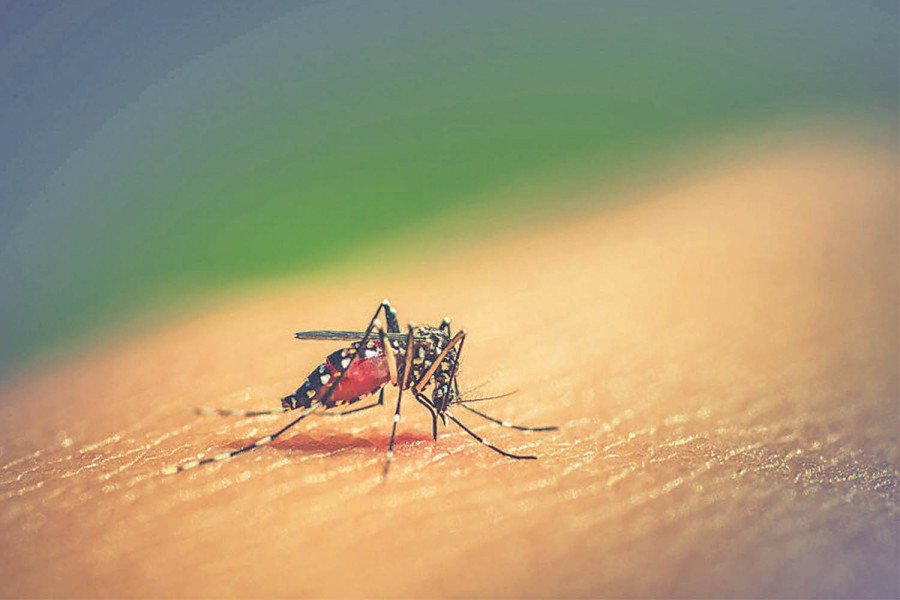Health
JE death toll rises to 23, development partners not driven to provide vaccine
Health Minister Pradip Paudel says he will hold a meeting with relevant officials and experts to discuss the emergency.
Post Report
At least 23 died, including one in Kathmandu Valley, and over 80 people have been infected with the Japanese encephalitis (JE) virus since June this year.
The number of reported cases could be just the tip of the iceberg, as tests were carried out only on those hospitalised patients after their conditions got severe, officials say.
“The death rate from the Japanese encephalitis infection is the highest among the vaccine-preventable diseases,” said Dr Bibek Kumar Lal, director of the Family Welfare Division. “Relevant health agencies have been taking all necessary measures to prevent infection and deaths from the virus.”
Cases of the deadly viral disease have been reported in 30 districts of six provinces except Karnali. What concerns health officials is the death rate rising alarmingly every year—around 29 percent in the current fiscal year. Fatality among children under 15 years is very high while complications from JE infection could cause permanent injuries to the brain and the nervous system.
Japanese encephalitis is a viral brain infection, endemic in Asia and parts of the Western Pacific. According to the World Health Organisation, it is a mosquito-borne flavivirus belonging to the same family as dengue, Zika, yellow fever, and West Nile viruses. The virus kills a third of those who fall ill and leaves up to a half of those who survive with severe life-long disabilities, according to the UN health body.
Data from the health ministry show that less than 50 percent of the infected patients were found inoculated with the vaccine. Doctors say the disease has no cure, so treatment focuses on managing symptoms. However, safe and effective vaccines have been developed to prevent infection.
Health officials, however, said that their attempts to convince development partners, including the World Health Organisation, for a mass JE vaccination campaign have not succeeded.
“We have raised the issue several times with officials from the Global Alliance for Vaccine and Immunisation and requested their support,” said Lal. “But as of now, none of the agencies is convinced to support JE vaccination. Either the government has to decide and secure the funding source, or the aid agency should invest in the JE vaccination.”
The National Immunisation Advisory Committee, an expert panel, has also not recommended mass JE vaccination despite the high mortality rate.
“Vaccine does not help in controlling the ongoing epidemic,” said Dr Ramesh Kanta Adhikari, senior immunisation expert and a National Immunisation Advisory Committee member.
“We are ready to carry out a feasibility study, hold review meetings and discussions with the concerned experts and stakeholders to recommend the JE vaccination campaign if the government decides the same.”
In 2005, JE killed nearly 2,000 people in Nepal—mostly children from the Tarai districts. Nepal started administering the vaccine doses in 2006, eight years before the World Health Organisation officially issued prequalification certification, due to high rates of infection and deaths from the virus at the time.
In the first phase, all populations of the highly affected four districts—Banke, Bardiya, Dang, and Kailali—were given the JE vaccine. Later, the vaccination programme was expanded to 19 other affected districts, and children under 15 were inoculated.
The government integrated the JE vaccine into routine immunisation in 2015. Even then, people still die, and dozens get infected by the deadly virus every year.
The Ministry of Health and Population said its attention has been drawn to the spread of a deadly virus that has killed around two dozen people and infected scores of others.
“I have called a meeting of the officials concerned from the Family Welfare Division to discuss the issue on Friday,” said Pradip Paudel, minister for health and population. “We have taken the issue seriously and will make some decisions to prevent deaths and infections from the JE virus.”
Public health experts say this is the right time to vaccinate all those at risk. Even if the vaccine does not help in outbreak management, it provides immunity against future infections.
The JE virus is transmitted to humans through the bite of infected Culex mosquitoes. Pigs and ducks are considered natural reservoirs of the virus.
Doctors advise avoiding mosquito bites, such as by using mosquito repellents, wearing long-sleeved clothes, and getting vaccinated if one lives in or travels to disease-endemic areas. They also stress the importance of awareness and timely treatment to prevent infections and deaths.
An estimated 12.5 million people are thought to be at high risk of JE infection in Nepal.




 19.12°C Kathmandu
19.12°C Kathmandu













